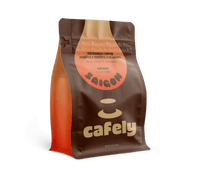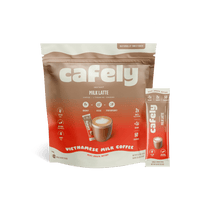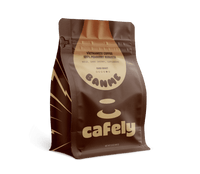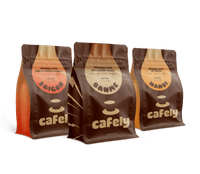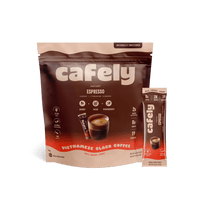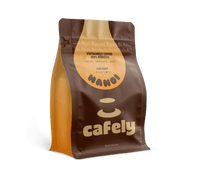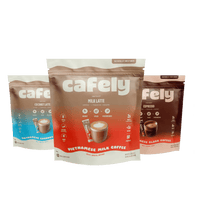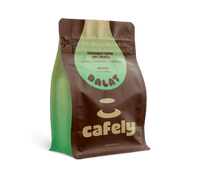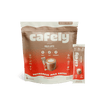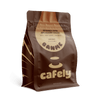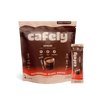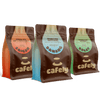Although coffee grounds aren’t toxic, they are biodegradable and can be beneficial to soil and compost. However, they can also be a hazard to animals and children.
You can throw coffee grounds in the trash as long as they're sealed in a biodegradable container or bag. However, there are far better ways to dispose of spent coffee grounds.
In this read, we’ll teach you eight ways to dispose of your grounds that’ll benefit you and the planet…
Don't Throw Away Your Coffee Grounds, Use Them Instead…
Before you throw your spent coffee grounds in the trash, think about using them. There are several ways used grounds can be used or recycled to benefit you, your garden, your health, and the environment.
Here are eight ways to use spent coffee grounds rather than throwing them away:
1. Compost the Grounds

Spent coffee grounds are rich in three essential nutrients for plant growth — nitrogen, phosphorus, and potassium (NPK). They also contain a range of other nutrients that help produce healthy foliage, root systems, and flowers in plants.
Adding coffee grounds to your compost bin helps speed up the composting process. The nitrogen in the grounds is essential for creating a balanced compost pile. It’s a key component in the decomposition of organic matter. It fuels the activity of microorganisms that break down any table scraps and garden waste that’s placed in the bin.
Instead of throwing your coffee grounds in the trash, composting them can help produce a complete substrate and fertilizer that your flowers and vegetables will thrive in.
2. Use the Grounds as Fertilizer
If you don’t have a compost bin or pile, you can use coffee grounds as a direct fertilizer. Even house plants can benefit from fertilization with spent coffee grounds.
Use coffee grounds as fertilizer by directly applying them to your flower beds, vegetable beds, or potted plants. Spent coffee grounds add essential nutrients and organic matter to the soil. They will improve water retention, aeration, nutrient profile, and overall soil quality.
3. Use Grounds to Deter Pests
If you have problems with pests such as slugs, snails, ants, and caterpillars in your garden, sprinkling coffee grounds around your plants can deter them.
Ants and other insect pests are irritated by the scent and acidity of the grounds. Slugs and snails find them uncomfortable to crawl across.
Cats and foxes are also deterred by the scent of coffee. If you have problems with cats and foxes defecating in your flower or vegetable beds, dumping your spent grounds around the plants can solve the problem.
4. Make a Coffee Body Scrub
Coffee grounds make an excellent exfoliant. Drying spent coffee grounds and combining it with coconut oil or honey creates a natural body and facial scrub. Coffee ground body scrubs remove dead skin cells, improve blood circulation, and leave your skin feeling vibrant and smooth.
The coffee grounds don't dissolve in water, which makes them excellent for exfoliation. According to some studies, caffeic acid — an antioxidant found in coffee grounds — may boost collagen levels and reduce premature aging of cells when applied topically [1].
The chlorogenic acids in coffee grounds may also reduce inflammation in the skin and around the eyes [2]. This could help in the treatment of inflammatory skin conditions such as eczema and acne as well as reduce puffy eyes.
The polyphenols in coffee may also protect against ultraviolet (UV) radiation. Although we don’t recommend swapping regular sun cream for coffee grounds, using coffee grounds on your skin may help reduce sun damage [3].
5. Use Coffee Grounds to Eliminate Odors

Coffee grounds absorb odors effectively. They are highly porous which allows them to trap unwanted odors from the air and certain surfaces. When spent coffee grounds are dried, they work similarly to activated charcoal, soaking up a variety of unpleasant odors.
The nitrogen in coffee grounds can also help neutralize sulfur gasses that cause bad smells. When coffee grounds come into contact with these odor-causing gasses (often caused by rotten food and waste), they bind to them and reduce their intensity. They may even improve the air quality in your home by absorbing sulfur and nitrogen gasses from the air [4].
If your refrigerator, laundry room, or pantry smells stale or unpleasant, try putting a pot of dried, spent coffee grounds inside to reduce and neutralize the odors.
6. Use Coffee Ground to Tenderize Meat
The natural acids and enzymes in coffee help break down fibers in meat, making it more tender.
Using spent coffee grounds as a dry rub for steak, pork, and chicken can enhance the flavor and texture of the meat.
Simply create a rub by combining coffee grounds with salt, pepper, and other spices. Coat the meat in the rub and leave in the refrigerator for four to 12 hours. When you’re ready to cook the meat, wipe off the grounds (or rinse) and cook as normal.
Meat that has been marinated with coffee grounds is softer, juicier, and produces a better crust.
7. Repair and Stain Wooden Furniture
Spent coffee grounds can be used to fill in scratches on wooden furniture and even work as a natural wood stain.
To repair scratched, tarnished furniture, simply mix spent coffee grounds with water to create a paste, then apply it to the affected area using a cloth. Leave the paste in place for a couple of minutes, then remove with a damp cloth.
You’d be surprised how well this works. I deeply scratched my oak dining table while moving. A light sand with a low-grit piece of sandpaper and a ground coffee paste solved the problem — it’s like it never happened.
8. Use Coffee Grounds to Grow Mushrooms
Coffee grounds are an excellent substrate for growing edible, gourmet, and medicinal mushrooms. They provide the perfect balance of nutrients and moisture for cultivation. They’re easy to sterilize and cost nothing.
If you’re interested in growing mushrooms, start saving up your spent coffee grounds in tubs. When it’s time to use the grounds, sterilize in a pressure cooker, fill some mushroom grow bags, and inoculate with your favorite mushroom spores.
How to Throw Coffee Grounds Away Responsibly
If you don't want to use your old coffee grounds for any of the above or simply use too much coffee, throwing the grounds away is okay. However, you should do so responsibly.
Coffee is poisonous to dogs, cats, and other animals. Disposing of them responsibly will keep your pets, your neighbors' pets, and wild animals safe.
Coffee grounds are also biodegradable and provide plants with three essential nutrients (nitrogen, potassium, and phosphorus). Disposing of them responsibly ensures their nutritional value to plants is not wasted.
Follow these tips to dispose of your coffee grounds responsibly:
- Seal the Grounds: Place your spent coffee grounds in a sealed bag or compostable container before disposing of them in the trash. This prevents animals from accessing them and keeps your garbage can clean.
- Recycle the Grounds: Coffee grounds are excellent for composting. Instead of throwing them in your regular trash can, place them in your “green waste,” compost them yourself, or take them to a local community garden.
- Avoid Disposing in Drains: Never throw coffee grounds down the sink or drain. They can clump and cause blockages in the plumbing and sewer systems. Instead, dispose of them in the trash or compost.
FAQs: Disposing Used Coffee Grounds
Learn more about the uses of coffee grounds, how to dispose of them, and other facts about coffee in the frequently asked questions below.
Want to find out more about the world of coffee? Check out the Cafely Blog.
1. Are Coffee Grounds Good for Plants?
Yes. Coffee grounds contain phosphorus, potassium, and nitrogen — three essential nutrients for plants. Coffee grounds are also slightly acidic, even once they've been used to make coffee. Adding too much to alkaline-loving plants could be detrimental.
2. Can I Throw Coffee Grounds In The Trash?
Yes. You can throw coffee grounds in the trash. However, if you have pets that occasionally get into the bin, it may be better to dispose of them separately. Coffee grounds are poisonous to cats and dogs and can be fatal if ingested.
3. Can Coffee Grounds Be Used To Repel Pests?
Coffee grounds can be used to deter pests in the garden. Placing them around plants can protect them from slugs and snails. Cats and foxes are deterred by the smell of coffee grounds. If you have problems with cats and foxes defecating in your flower beds, putting coffee grounds down can prevent it.
Some people also burn coffee grounds like incense to ward off mosquitoes and other insects. The slow-burning grounds release a strong, earthy aroma that many bugs dislike, making it a natural option for outdoor pest control.
4. What Should I Do If My Dog Ate Coffee Grounds?
Coffee grounds are extremely toxic to dogs and cats. They can be fatal if ingested. If your pet eats coffee grounds, contact your vet immediately.
5. Can I Pour Coffee Grounds Down the Drain?
You shouldn't pour coffee grounds down the drain in your sink. They could cause a blockage in your plumbing and/or the sewer system in your neighborhood.
6. Can You Put Coffee Grounds in a Compost Bin?
Yes. Coffee grounds are best composted. They contain the top three vital nutrients for plants — nitrogen, potassium, and phosphorus — as well as a range of micronutrients that are beneficial for soil and plant health.
7. What’s the Difference Between Arabica and Robusta?
Arabica and robusta are two different types of coffee beans from coffeespecies — thinner, more delicate looking Coffea arabica and thicker, sturdier Coffea robusta plants. Although both are coffee beans, they produce brews with vastly different characteristics. Robusta beans produce a strong, dark, highly caffeinated brew. Arabica beans produce a smooth, sweet, full-bodied brew.
8. What’s the Strongest Type of Coffee?
The strongest type of coffee bean is Robusta. Robusta coffee has twice the amount of caffeine as arabica. The brewing method also affects caffeine content. Extraction methods that involve fine grounds and pressurized water produce the strongest coffee. Ristretto (a highly concentrated espresso shot) made from robusta beans is the strongest coffee.
9. What is Mexican Coffee?
Mexican coffee (Café de Olla) is a complex arabica brew that’s enriched with cinnamon and piloncillo (unrefined cane sugar). It’s brewed in a clay pot known as an “Olla.”
10. What is Turkish Coffee?
Turkish coffee is a rich, dark brew made by boiling extra fine arabica coffee several times in a pot known as a cezve. It's unfiltered, with a deep body and intense flavor. Served in small cups called “fincans,” Turkish coffee is a traditional brew that's unlike any other hot-brewed coffee on the planet.
References
- Magnani, C., Isaac, V. L. B., Correa, M. A., & Salgado, H. R. N. (2014). Caffeic acid: a review of its potential use in medications and cosmetics. Analytical methods, 6(10), 3203-3210.
- Girsang, E., Ginting, C. N., Lister, I. N. E., yashfa Gunawan, K., & Widowati, W. (2021). Anti-inflammatory and antiaging properties of chlorogenic acid on UV-induced fibroblast cell. PeerJ, 9, e11419.
- Fukushima, Y., Takahashi, Y., Hori, Y., Kishimoto, Y., Shiga, K., Tanaka, Y., ... & Kondo, K. (2015). Skin photoprotection and consumption of coffee and polyphenols in healthy middle‐aged Japanese females. International Journal of Dermatology, 54(4), 410-418.
- Bejenari, V., Marcu, A., Ipate, A. M., Rusu, D., Tudorachi, N., Anghel, I., ... & Lisa, G. (2021). Physicochemical characterization and energy recovery of spent coffee grounds. Journal of Materials Research and Technology, 15, 4437-4451.
